Saluting 40 years of service
by the Women’s Army Corps (WAC) of the Guyana Defence Force (GDF) -
on International Women’s Day - March 8, 2007
Compiled By Wendella Davidson
 |
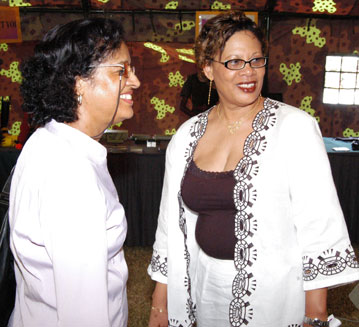 |
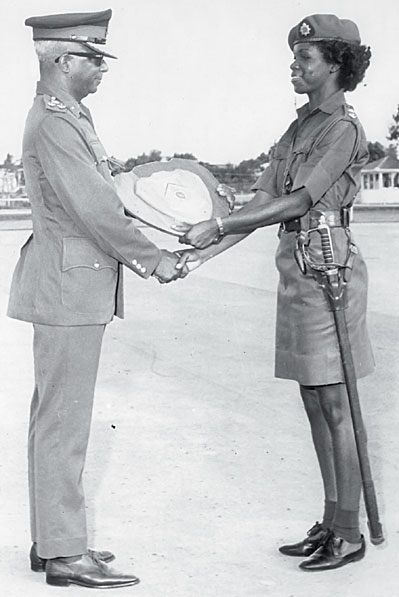 |
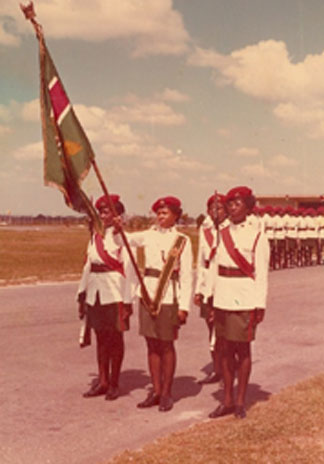 |
 |
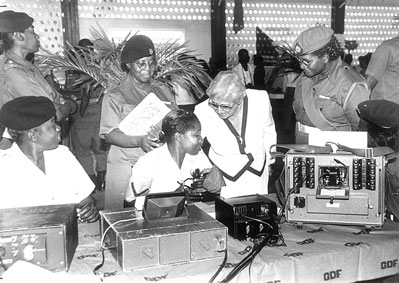 |
 |
International Women's Day ( March 8) is an occasion marked by women's groups around the world. This date is also commemorated at the United Nations and is designated in many countries
as a national holiday. When women on all continents, often divided by
national boundaries and by ethnic, linguistic, cultural, economic and
political differences, come together to celebrate their Day, they can
look back to a tradition that represents at least nine decades of
struggle for equality, justice, peace and development.
International
Women's Day is the story of ordinary women as makers of history; it is
rooted in the centuries-old struggle of women to participate in society
on an equal footing with men. In ancient Greece, Lysistrata initiated a
sexual strike against men in order to end war; during the French
Revolution, Parisian women calling for "liberty, equality, fraternity"
marched on Versailles to demand women's suffrage.
The
idea of an International Women's Day first arose at the turn of the
century, which in the industrialized world was a period of expansion
and turbulence, booming population growth and radical ideologies.
Following is a brief chronology of the most important events:
1909
In
accordance with a declaration by the Socialist Party of America, the
first National Woman's Day was observed across the United States on 28
February. Women continued to celebrate it on the last Sunday of that
month through 1913.
1910
The
Socialist International, meeting in Copenhagen, established a Women's
Day, international in character, to honour the movement for women's
rights and to assist in achieving universal suffrage for women. The
proposal was greeted with unanimous approval by the conference of over
100 women from 17 countries, which included the first three women
elected to the Finnish parliament. No fixed date was selected for the
observance.
1911
As
a result of the decision taken at Copenhagen the previous year,
International Women's Day was marked for the first time (19 March) in
Austria, Denmark, Germany and Switzerland, where more than one million
women and men attended rallies. In addition to the right to vote and to
hold public office, they demanded the right to work, to vocational
training and to an end to discrimination on the job.
As
a result of the decision taken at Copenhagen the previous year,
International Women's Day was marked for the first time (19 March) in
Austria, Denmark, Germany and Switzerland, where more than one million
women and men attended rallies. In addition to the right to vote and to
hold public office, they demanded the right to work, to vocational
training and to an end to discrimination on the job.
Less
than a week later, on 25 March, the tragic Triangle Fire in New York
City took the lives of more than 140 working girls, most of them
Italian and Jewish immigrants. This event had a significant impact on
labour legislation in the United States, and the working conditions
leading up to the disaster were invoked during subsequent observances
of International Women's Day.
1913-1914
As
part of the peace movement brewing on the eve of World War I, Russian
women observed their first International Women's Day on the last Sunday
in February 1913. Elsewhere in Europe, on or around 8 March of the
following year, women held rallies either to protest the war or to
express solidarity with their sisters.
1917
With
two million Russian soldiers dead in the war, Russian women again chose
the last Sunday in February to strike for "bread and peace". Political
leaders opposed the timing of the strike, but the women went on anyway.
The rest is history: Four days later the Czar was forced to abdicate
and the provisional Government granted women the right to vote. That
historic Sunday fell on 23 February on the Julian calendar then in use
in Russia, but on 8 March on the Gregorian calendar in use elsewhere.
Since
those early years, International Women's Day has assumed a new global
dimension for women in developed and developing countries alike. The
growing international women's movement, which has been strengthened by
four global United Nations women's conferences, has helped make the
commemoration a rallying point for coordinated efforts to demand
women's rights and participation in the political and economic process.
Increasingly,
International Women's Day is a time to reflect on progress made, to
call for change and to celebrate acts of courage and determination by
ordinary women who have played an extraordinary role in the history of
women's rights.
The Women’s Army Corps (WAC) of the Guyana Defence Force (GDF).
WOMEN
in the Guyana Defence Force (GDF) are treated collectively as members
of the Women's Army Corps (WAC) which was formed on January 30, 1967,
initially to function as a reserve unit.
However,
the WAC which celebrates February 6 as its formation day, possesses its
own emblem (the Victoria Regia Lily with crossed rifles), flag (the
emblem on a mauve background), and Regimental march.
In
theory, women in the GDF enjoy equal status to men: they compete with
them in training and, within their respective corps for promotion. They
also suffer similar sanctions whenever they commit offences; receive
equal pay within their ranks; undergo similar training, and benefit
from all the privileges of military life as do the male soldiers.
The
underlying belief therefore is, given the opportunity to be properly
trained, women can carry out almost any function that is required of
men.
Establishment
The WAC arguably was the result of a direct consequence of Venezuela’s seizure of Ankoko Island in the Cuyuni in October 1966.
In
that year, the GDF had barely established its first battalion of fewer
than 500 men when it was forced to deploy troops to Eteringbang on the
country’s westernmost frontier to confront Venezuela’s aggression.
Troops
based on the coastland had to be flown hurriedly into the hinterland.
The sudden removal of such a large number of men from such a small
force, some mere recruits still undergoing basic training , others
deployed along the coastland with only two years earlier had been the
scene of murderous ethnic strife, created huge manpower problems.
Soldiers had to be found quickly to secure the borders and others had to take their place in the camps.
The solution was to recruit women.
Recruitment
Just
three months after the Ankoko incident, on January 30, 1967, four women
intended to be officers -Captain Joan Granger ( commissioned) and
Officer Cadets Brenda Aaron, Clarissa Hukumchand and Hyacinth King - of
the First Company of the Women’s Volunteer Corps, underwent a special
one-week orientation course at Atkinson Field subsequently renamed the
GDF Training Wing, Base Camp Stephenson, Timehri.
On
Sunday February 6, 1967 they were joined by 56 other women, taken on as
recruits and underwent five weeks of training in drill, field-craft,
skill-at-arms, shooting and physical fitness at Atkinson Field.
The
course was divided into squads under instructors Colonel C.E.
Martindale, RSM (Regimental Sergeant Major) Sargeant and three
Sergeants, Oliver, an expatriate; Kahleel and Hartley Liverpool.
All
60 women were formally inducted into the GDF at a parade on March 12,
inspected by Mrs. Winifred Gaskin, then Minister of Education.
On that day they created history in South America as the only women’s army in the region.
The
squad trained by Liverpool was adjudged the best squad at the Passing
Out Parade with WAC Gwen Davis being adjudged the `Best Recruit’.
During
the course the female soldiers were allowed to work in the departments
where their skills were required e.g; as drivers, cooks, typists,
store-women, mess staff, members of the Military Police (MP) and
Intelligence Corps (Int. Corps).
At
the initial stage they started out as reservists and were to assemble
once per year for training, but most of them were absolved into the
units hence the concept of a reservist was not necessary.
A
few officers were given the opportunity to attend "attachments" and "on
the job training" overseas. For example, Michalene Payne was trained at
the British Army Public Relations Department; Joan Granger was trained
at the Army School of Catering, and Brenda Aaron at the Women's Royal
Army Corps (WRAC), all in the UK.
The
doors to regular officer training in Guyana were opened on 16 May 1976
when eight women - four civilians and four soldiers - were admitted to
the Standard Officers Course (SOC) which all cadets must complete
before being commissioned as officers.
MAKE WAY FOR THE GIRLS
...They’re in the Army now
By Sibille Hart ( Reprinted from the Sunday Graphic, March 12, 1967)
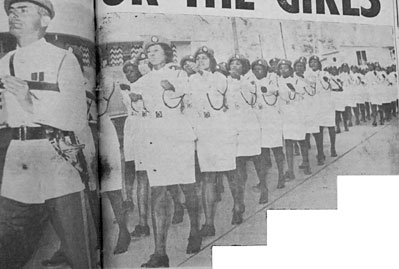 |
||
| At the passing out parrade March 12,1987. (Sunday Graphics file photo) |
||
Donning
the military khaki uniforms, members of the First Company of the
Women’s Volunteer Corps of the Guyana Defence Force have after five
weeks of rigorous training been transformed into the fast-talking,
brisk-walking, women soldiers who have trail-blazed a new, exciting
career for women in the country.
Led
by the company’s first four officers – Captain Joan Granger and Cadet
Officers Clarissa Hukumchand, Brenda Aaron and Hyacinth King – the
soldiers smartly clad in the colourful ceremonial dress of scarlet,
green and white made a terrific impact when they made their first
public appearance at the Passing Out parade on Friday afternoon.
But
little, I’m sure did the admiring and proud public realize just how
rigorous and exhausting the five weeks training really was.
It was tough, it was competitive, it was “exciting”, for, after all, it was new.
After
spending three-quarters of a day watching the women soldiers in action,
I was convinced that efficiency was much more than the key note.
This was the pattern of their daily training.
* * 5.30 a.m general military exercises, including drill and physical training , weapon training and shooting.
*
10:30 am specialist training – which is in itself divided into three
categories – administrative platoon …for clerks, store keepers, and
cooks; mechanical transport platoon . . . for drivers, and mechanics;
and signals platoon . . . for radio and telephone operators.
Except
for the usual lunch and tea breaks, the training was continuous and
rigid and I was told, was completed around 7 p.m. each day after which
they retired to the bright, airy sitting rooms or dormitories.
The
dormitories are painted bright pink, and each carries two single beds,
a twin cupboard, a table and a chair, while the sitting rooms are
furnished with comfortable basket chairs and colourful scatter cushions.
For relaxation, there is an up to date library, a basket-ball court where film shows are also held, and a canteen.
FROM ALL PARTS
The
girls have three basic uniforms – red blouses and white shorts for
physical exercises; green khaki slacks and shirts and floppy hats for
outdoor training, shooting and drilling; and the tailored khaki shirts
and skirts and matching green berets and shoulder bags for officer and
indoor duties.
The
women soldiers come from a wide variety of fields; there are teachers,
store clerks and commercial students, and were chosen from all parts of
the country.
There are two Amerindians in the batch.
They all had one common quality-curiosity about army life and an eagerness to learn.
According
to their leader, Captain Joan Granger, “ The girls were all very
co-operative and have made their training period a success, since each
pulled her own weight and measured up to all her responsibilities.”
There
were some 800 applications from women desiring to join the Women’s
Corps, 50 to 60 of which were for officers’ posts. Only three officers
were however necessary for the first company.
Having
completed the five-week course for which they were fully paid according
to the army rates, the recruits will now return to civilian jobs, but
will be requested to work with the Guyana Defence Force (GDF) for a
minimum of one weekend each month for which duty they will be paid.
Chief
of Staff Colonel Ronald J. Pope commenting on the progress of the
training, said:” The girls have been outstanding, and were definitely
one of the best batches of trainees we’ve ever had.”
WAC opens 40th anniversary celebrations
By Wendella Davidson
CELEBRATIONS
to observe the 40th anniversary of the Women’s Army Corps of the Guyana
Defence Force (GDF) began on February 1, 2007 with a Thanksgiving
Service in the auditorium at the Army’s Base Camp Ayanganna, Thomas
Lands, Georgetown.
There
was an overwhelming feeling of nostalgia and camaraderie as ex-female
officers and other ranks gathered for the service embraced each other.
Among
those at the service were some of the initial 60 females who formed the
first company of the WAC -- ex- Lieutenant Clarissa Hukumchand, now
Riehl, acting Speaker of the National Assembly; ex-Woman Warrant
Officer Class 11 (retired) Margaret `Maggie’ Arthur; Ex-Woman Sergeant
Gweneth St Clair, and Ex-Woman Sergeants Norma Scott and Pansy
Patterson-Skerrett .
Riehl,
an attorney, is a Member of Parliament; Arthur is a teacher; Sinclair
and Skerrett are serving as civilian workers in the GDF, while Scott is
credited with being the first military policewoman (MP) in the GDF.
Present
too, were differently-able retired Colonel Hartley Livepool, also known
as the `Black Prince’, who was one of the training officers for the
first batch; and Lieutenant Col (Retired) Christine King, Chief
Executive Officer of the Ethnic Relations Commission (ERC); former
Chief of Staff, Major General Norman Mc Lean; present Commanding
officer of the WAC, Lieutenant Colonel Windee Algernon, ex-female
soldiers and serving officers, non-commissioned officers and other
ranks of the GDF.
Representing
the government were three serving female ministers -- Minister of
Public Service, Dr. Jennifer Westford; Ms. Carolyn Rodrigues, Minister
of Amerindian Affairs; and Ms. Priya Manichand, Minister of Human
Services and Social Security.
The
Guyana Prison Service, the Guyana Fire Service and the Guyana Police
Force were represented by Ms. Lena Williams; Ms. Desiree De Santos and
Ms. T. Thompson–Howard, respectively.
GDF
Chief of Staff, Brigadier General Edward Collins, in a message to mark
the occasion, urged the female soldiers to “take full advantage of the
enabling environment currently existing at both the global and domestic
levels.”
Noting
that 32 women are heads of state at the global level, he said the women
soldiers should be encouraged by the universally accepted fact that no
country can compete in today’s competitive, globalised economy when
half of its human capital is marginalized or limited.
Women’s rights and empowerment, he said, are fundamental building blocks of any responsible and accountable government.
He
noted that at one time, women soldiers could have only enlisted in the
GDF Reserve, and for a period of no more than three years during which
time they could have been “disembodied”, or have their full-time
service stopped at any time if their position had become redundant.
In addition, he said, they were trained for non-combat duties, including catering and medical duties.
However,
Collins said that because of a struggle by the female soldiers to be
treated no less favourably than their male counterparts, women soldiers
can today be found in almost every unit and department of the GDF.
He
added, “…we are convinced that once given the opportunity to be
appropriately trained, women can carry out almost any function that is
required of men in accordance with that training.”
It
was on this note that he recognized the feats of ex-Woman Sergeant
Beverly Somersett nicknamed `Thriller’, the first female to climb Mount
Ayanganna, and Second Lt. Samantha Chung, the first female officer to
arrive at the mountain peak in 2004.
Others
publicly recognized were W/Able Rating Collins and W/Leading Rating
Orlene Nurse, the first female soldiers of the Coast Guard to sail on
the U.S. Coastguard Cutter, the USS Gentian; and W/Staff Sergeant
Suzette Lavric, the first female from the GDF to join the CARICOM
Disaster Unit in Grenada in response to Hurricane Ivan. She was later
joined by W/CPL Duncan; W/LCPL Cole and W/PTE Wilson serving as
caterers and carpenter, respectively.
W/Lt
Christine Bradford, who headed a Colour Party comprising of escorts
Warrant Officer, Class II, Hulda Peters and W/Sergeants Glenis Joseph
and Uranie Batson, at the Thanksgiving service, was hailed for leading
an all female 13-member team of soldiers in commemoration of the GDF’s
40th anniversary in 2005.
In
a sermon themed “Corporate and Individual Confidence”, Chaplain of the
Guyana Prison Service, Reverend Faye Clarke assured WAC members that
they can stand fast knowing that it is God who has brought them thus
far and will continue to guide them in the future.
The
thanksgiving service also featured the presentation of the `Colour’ to
Force Chaplain Reverend G. Thompson, prayers by representatives of the
Hindu, Muslim and Christian faiths, scripture readings, a most
appropriate rendition of “The Storm is over now” by the Joint Services
Choir with Fireman Wilbur Evans as the lead vocalist, and Tracy Hall
and others of the GDF Frontline Band singing “To God be the Glory.”
And,
at an exhibition mounted on the Camp Ayanganna playfield on February 6,
which showcased the skills of females on the job in art, craft,
pictures and culinary delights, Lieutenant Colonel (Retired) Christine
King who declared the event open, urged the women soldiers to build on
the rich legacy of the Corps.
She
also challenged the women soldiers to seek to build on their combat and
non-combat skills which will prepare them for the demands of the Army
and those of the society.
Lamenting
the apparent paucity of historical material on the Women’s Army Corps
(WAC) of the Guyana Defence Force (GDF), the former head of the WAC
suggested the undertaking of a special project for posterity.
Remarking
that the exhibition was not the first of its kind for the WAC nor the
first that Army women have participated in exhibitions, having
represented the Force and the Corps on numerous occasions at
exhibitions even at the national level, she said “there seems to be a
paucity of historical material on the Women’s Army Corps, and since we
already have a military museum, it would be worth the while to engage
in a special project for the 41st Anniversary aimed at the compilation
and preservation of items of significance for the benefit not only of
serving members, but for future members of the Force and for posterity.”
According
to her, “The United States Army Women in 2005 observed 50 years since
the establishment of their museum. The museum displays artifacts,
exhibits and photographs that trace the history of women in the U.S.
army from the early 1940s. In like manner the British and Canadians
have preserved records, photographs and other materiel of women who
served their respective armies over sixty years ago.”
Of
the WAC, King said, the unit plays an important role in the operations
of the GDF and recalled that at the outset, it was meant to provide a
body of trained officers and women to be a ready reserve in any type of
emergency, and to reinforce the regular elements and replace them in
non-combatant duties.
“It
is with this in mind that Army women have been given access to training
to acquire skills of soldiering. But despite limitations in terms of
their combat role, however, female soldiers have fulfilled their
mandate and have served the Force with distinction over the past four
decades. Of course, this could not have been done without the support
of the Force’s administration and government, past and present.”
To
cheers from the females, King posited that women in the Army have the
edge over their male counterparts because of their diverse skills which
prepare them for life beyond the GDF.
A
random check at the security services will reveal that there are more
ex-Army men in the security services than Army women, and the women who
are not in the security services are either more qualified or have
several skills for employment in a variety of areas, she added.
It
was on this note that King challenged all the serving female soldiers
to “aim at building on your combat and non-combat skills as best as you
can; this will prepare you for the demands of the Force as well as that
of the society at large.”
Standing
tall and proud among the women and to a warm welcome from the audience,
though differently able through the loss of his sight, Lt. Col.
Liverpool, who resides overseas, delivered greetings on behalf of the
ex-GDF Association, New York Chapter.
Considered
an icon on the historical aspect of the GDF in addition to the WAC,
having served in all the units of the Army, Liverpool, one of the first
four instructors of the initial batch of females of the WAC, spent some
time reminiscing with the audience on some of the occurrences prior to,
leading to, and after the formation of the WAC.
An
impressive dance display `Amour’ by the five females of the Donamix
Dance Group of the Newtown Assemblies of God Church, Newtown, Kitty,
wearing camouflage hats, and jerseys complemented by black over-vests
and pants, was all part of the opening session.
Following,
those present viewed the display of pictures of past and present female
officers and soldiers; equipment used at work by the females and other
things on show.
In
an invited comment after being taken on a conducted tour by Lt Col.
Algernon, Minister Fox lauded the members of the WAC who she described
as “real models for women in the society - young women and even women
who are married with kids - who have sacrificed their lives to serve
their country.”
“I’m
really impressed with the exhibition because of the way they (female
soldiers) were able to articulate what is happening in every field they
are in and in spite of all of that, that there is the soft side of
women in this Army.
“I’ve
always been fascinated by the Women’s Army, particularly because I know
they have to be so strong in everything, all the things that the men
are doing they have to do, and in some instances they probably do it
better than the men. They are fit and are dedicated to serving the
country and in spite of everything, of all we say about Guyana, we have
some of the toughest women...and we can see that the cream of the crop
serve in the Army. They are keeping the faith, they’re strong, their
maternal instincts are strong too,” the minister added.
Among
those at the exhibition were Brigadier General ; Lt. Col. Windee
Algernon; Minister in the Ministry of Education, Dr. Desrey Fox; Ms.
Clarissa Riehl; Ms. Cheryl Pickering–Moore, the first female pilot in
the GDF, now a serving pilot with LIAT; W/Major (Retired) Michalene
Wilson; Lt. Col. (Retired) Hartley Liverpool, Ms. V. Primo and Ms.
Ingrid King representing the ex-GDF associations of New York and
Canada, respectively; Senior Officers, Warrant Officers, Senior
Non-Commissioned officers and soldiers (serving and retired), civilian
employees and friends of In an invited comment after being taken on a
conducted tour by Lt Col. Algernon, Minister Fox lauded the members of
the WAC who she described as “real models for women in the society -
young women and even women who are married with kids - who have
sacrificed their lives to serve their country.”
“I’m
really impressed with the exhibition because of the way they (female
soldiers) were able to articulate what is happening in every field they
are in and in spite of all of that, that there is the soft side of
women in this Army.
“I’ve
always been fascinated by the Women’s Army, particularly because I know
they have to be so strong in everything, all the things that the men
are doing they have to do, and in some instances they probably do it
better than the men. They are fit and are dedicated to serving the
country and in spite of everything, of all we say about Guyana, we have
some of the toughest women...and we can see that the cream of the crop
serve in the Army. They are keeping the faith, they’re strong, their
maternal instincts are strong too,” the minister added.
Remembering the Women’s Army Corps in PHOTOS
FIRST OF OUR GIRLS
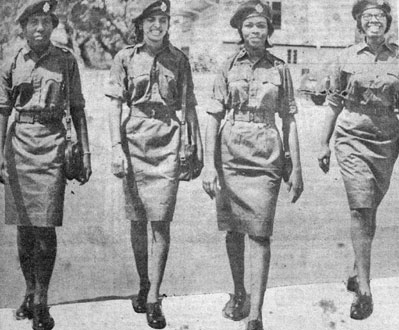 |
|
The
four female officers were first taken on a tour of GDF headquarters,
Thomas Lands and met with Chief of Staff, Colonel R. J. Pope and other
officers.
Here,
the first female army officers, from left, Brenda Aaron, Clarissa
Hukumchand, Hyacinth King and Captain Joan Granger, in their uniforms
of green khaki shirts and blouse, green berets, shiny black shoes and
shoulder bags at Camp Ayanganna. Reprinted from Guyana Graphic, Tuesday, January 31, 1967 (Winston Oudkerk photo)
The first batch of new recruits
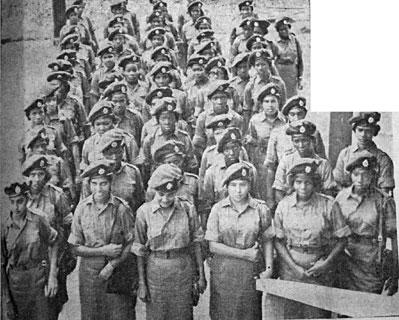 |
|
(Winston Oudkerk photo)
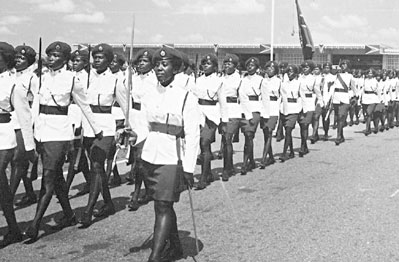 |
|
It was also a significant event for women as that year was designated International Women's Year.
Officer
in charge of the parade was Major Brenda Aaron and the colour party
comprised Lt Cheryl Pickering, colour ensign, Sgt Lorraine Solomon and
Cpls Lynette Smith and Marva Nedd'. (Photo, courtesy of Pilot Cheryl-Pickering-Moore)
 |
| Ret’d W/SSGT Gyneth Pile-Sinclair |
Pile-Sinclair was rehired as a civilian works and serves in the Welfare Department.
Her
greatest thrills were the jungle, nature and the forest. She found
working with a compass and maps in dense jungle quite exciting.
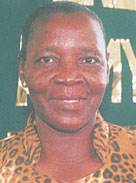 |
| Ret’d W/SGT Pansy Patterson-Skerrett. |
The
six of 11 children, Patterson-Skerrett was assigned to the Ordnance
(Stores) Corps after the passing-out parade. She remained there until
retiring as a Sergeant in 1987. Rehired as a civilian worker,
Patterson-Skerrett, one of the first recipients of the Military
Efficiency Medal (MEM) which was bestowed by then President Arthur
Chung, retired as a civilian in November 2005 but with still much to
offer she was again rehired and is still on the job.
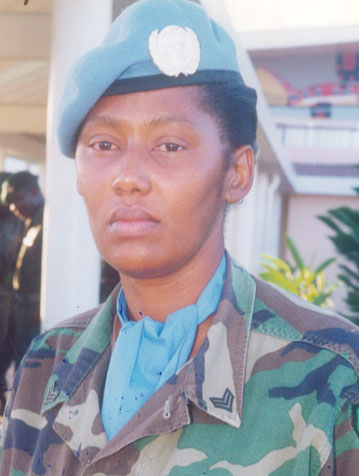 |
|
Sergeant Agnes Duke |
Though
deployed as a computer operator, Duke was required to perform tasks
like her male counterparts, including physical activities,
counter-patrol, shooting and weapon training.
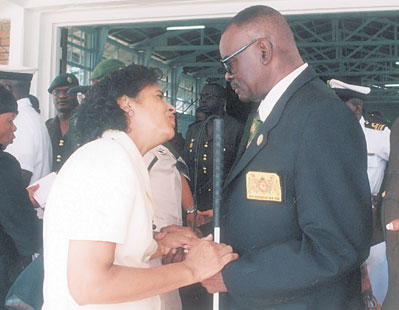 |
| It must have been quite a nostalgic moment for Deputy Speaker of the National Assembly/Attorney-at-law, Clarissa Riehl when she met with her former trainer, Lt. Col. (Re’td) Hartley Liverpool, now sightless, during the Thanksgiving Service to held on February 1, 2007 to observe the 40th WAC Anniversary in the GDF auditorium. Ms Riehl was one of the first four women recruited to serve in the GDF as officers. She held the rank of Lieutenant. |
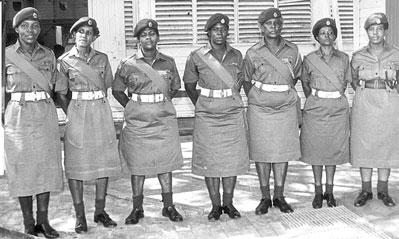 |
| Seven soldiers who were in the Women’s Army Corps from its inception, from left, Sergeant Skerett; Sergeant Wood; Staff Sergeant Sinclair; Staff Sergeant Croft; Warrant Officer 11, Duncan; Warrant Officer 11, Arthur and Major Aaron, pose during the 20th Anniversary of the WAC, February 1987. They all received gold ring from wife of then Chief of Staff, Major General, Norman Mc Lean on the occasion. ( Chronicle file/Winston Oudkerk photo) |
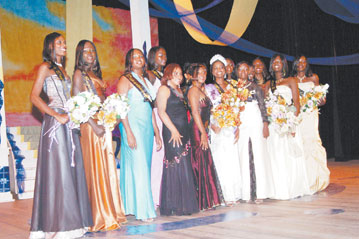 |
| Newly crowned Miss GDF 2007, L/CPL Ann Marks and other pageant delegates (Quacy Sampson photo)Newly crowned Miss GDF 2007, L/CPL Ann Marks and other pageant delegates (Quacy Sampson photo) |
 |
| From left, Chief Executive Officer, Ethnic Relations Commission(ERC/ Ret‘d Lt. Col., Christine King; Deputy Speaker of the National Assembly/ Attorney-at-law/former Lieutenant, Clarissa Riehl; Minister of Public Service, Jennifer Westford; Minister of Amerindian Affairs, Carolyn Rodrigues and Minister of Human Services, Priya Manichand at the WAC 40th Anniversary Thanksgiving Service in Camp Ayanganna on February 1, 2007. (Winston Oudkerk photo) |
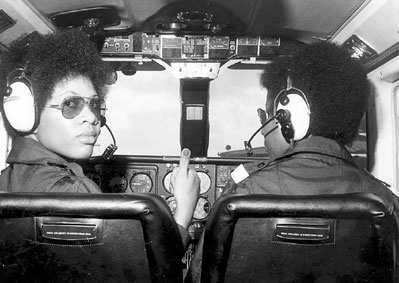 |
| Cheryl Pickering-Moore, the first female helicopter pilot in the Guyana Defence Force with another of her colleagues Beverly Drakes in one of the GDF helicopters. Pickering and Drakes both received training at Embry Riddle Aeronautical University (ERAU) in Daytona Beach, Florida, U.S.A (Photo courtesy of Cheryl Pickering-Moore) |
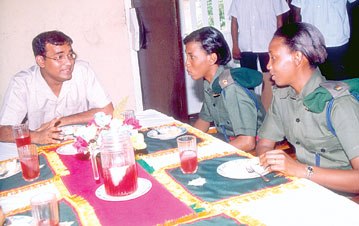 |
| President
Bharrat Jagdeo chats with Privates Susan Richards and Angela Cole, both
evelvated to the rank of Major for the day (Chronicle file /Winston
Oudkerk photo ( December 1999) |
GREETINGS
ON
THE occasion of our 40th Anniversary, I am honoured to be at the helm
of this distinctive body of women who are deserving of the highest
acclaim. The road we have traversed to this point has been a hard one,
lined with many pitfalls and challenges but there have also been
several victories and successes. Yet, we as a body of women have moved
forward, not just in years but in stature and have made great strides
and inroads into a male dominated arena.
To
our pioneers, the first batch of females who enlisted in our beloved
Defence Force, I salute you, for it was through your determination and
resilience that the Women’s Army Corps was birthed. I also wish to
acknowledge the contributions made by all former female officers and
other ranks , especially W/Major Joan Granger (now deceased); W/Lt Col.
Brenda Aaron (ret’d), W/Lt Col. Y Smith (ret’d), W/Lt Col. Christine
KingW/W02 Arthur M, W/W01 Joseph J, and w/w01 Harmon Y. Undoubtedly,
had it not been for your firm and steadfast hand of leadership, the
Women’s Army Corps would not have achieved the respectability and
admiration from the men folk that it enjoys today. To us, your
contributions to the development of women in the Army have been
invaluable.
To
all the serving members of the Corps, I salute you as well. It is
through your determination that we can boast of a history which
recorded females as us: Base Commanders, Staff officers, pilots,
plumbers, electricians, welders, tin smiths, force drivers and holders
of degrees in education, law, medicine, computer science and modern
languages. Females have also carried the Force’s colours in ceremonial
parades, sailed on the U.S. Cutter Coast Guard Gentian and formed part
of a disaster preparedness unit.
Today,
we enjoy similar remuneration to that of our male counterparts and are
exposed to similar training courses, both locally and overseas.
Finally,
to our Chief of Staff, male officers and ranks who have treated us
respectfully and equally, we thank you for your support. Amidst our
euphoria and celebratory mood, however, we wish to assure you that we
are committed to fulfilling our mandate in ensuring we remain in a
steadfast supportive role to our men folk in pursuit of a more
effective and productive GDF.
May God continue to bless the Women’s Army Corps and the Guyana Defence Force (GDF).
Woman /Lieutenant Colonel Windee Algernon, Head, Women’s Army Corps
FORTY
years ago the Guyana Defence Force opened its arms to embrace a body of
women comprising four officers and fifty-six other ranks, the
courageous pioneers of the Women’s Army Corps. That was a proud moment
for the Guyana Defence Force, the women in uniform and for Guyana as a
whole.
The
first intake of female soldiers was fully aware of the great
responsibility placed upon our shoulders and while we were expected to
give the best quality of support to the male soldiers, the onus was
upon us to establish the Women’s Army Corps upon a solid foundation. It
was the hope, that all of us, including subsequent batches, would be
able to stand firmly, and fly the flag of excellence at all times.
Indeed, that was a great challenge.
Over
the years, there have been many remarkable accomplishments while in
some areas the Women’s Army Corps fell short of expectation, leaving
room for improvement and an opportunity for progress. There was always
the obvious reminder that we needed to prove ourselves worthy of the
mantle we carried.
Though
formidable this task, female soldiers have always proven that even the
most difficult hurdle can be overcome, and, like the sky, the mountain
top can be reached again and again.
Army
women have displayed a tenacity of purpose. They have used commendation
and praise to bolster the Corps’ image, morale and esteem. In like
fashion they have embodied criticism, constructive or otherwise, to
their professional advantage.
Today, the challenge for you who now serve is no less.
Women
of the Guyana Defence Force have always been in the forefront of the
struggle for the full emancipation of women in Guyana and the
Caribbean, in the socio-economic, cultural and professional fields.
Our
women in GDF have served and supported our male counterparts in all
units of the Force; often holding and commanding sensitive and
difficult positions. We are proud of you today as we have been proud of
the pioneers in 1967 and throughout the years of their sterling service.
Today,
I commend and express sincere gratitude to Commanding Officer, WAC,
Lieutenant Colonel Windie Algernon, all other officers and other ranks.
In like manner, I embrace every female soldier who has diligently served in the past.
I
thank and commend the Chief of Staff, Brig. Gen. Edward Collins, all
male officers and ORs who have supported us over the years and continue
to do so. I also remember with heartfelt appreciation the magnanimous
and selfless co-operation and guidance given to us by our past leaders
and other ranks who walked with us as sisters in a wonderful and
treasured partnership of service to our beloved Guyana.
May
God bless all of you with goodwill, faith, determination and fortitude
to carry on this noble tradition of service to GDF and to Guyana.
Brenda B. Aaron, Lt. Col. Ret’d
Former WAC Commanding Officer
CONGRATULATIONS fine soldiers of the Women’s Army Corps (WAC) on your 40th anniversary.
You
have set a fantastic example to military women throughout the region.
You are role models for young Guyanese - male and female
- and are worthy to salute our flag. Always be conscious of your vital
role in society and continue to be our "Helens of Troy"
Best wishes for the future
Hyacinth King
CONGRATULATIONS to the Women's Army Corps of the Guyana Defence
Force (GDF) on the attainment of its 40th Anniversary.
I
am proud to be among the initial enlistment of women and it is a great
honour to send greetings to members of such a distinguished
organization.
Although
I now reside in the United States, that feeling of camaraderie which I
shared with my fellow female soldiers will always remain with me.
May the Corps continue to grow in fortitude and esteem in the years ahead.
Best Wishes
Gwen Fredericks, Ex GDF Captain
FEBRUARY
6th 1967 is a significant date in the history of Guyana. This date
marks a giant step for women in general in Guyana and for the GDF in
particular. It is the day that the first batch of women was inducted
into the armed forces of our nation.
On
this the 40th anniversary of the WAC, I look back with pride and
satisfaction. I am happy that I accepted the challenges and the
uncertainty of the unknown; but with hard work, sacrifice and
dedication, we were not only able to serve Guyana with distinction but
also able to set the example and leave a legacy of which we (women
soldiers) are justly proud.
To
the now serving members of the WAC I applaud you for choosing to serve
our country in this tough but rewarding profession and thank you for
upholding our mantle of service, pride and tradition.
As
we celebrate our 40th anniversary where ever we are let us resolve to
take pride in our history, let us resolve to always be shining examples
of the WAC of Guyana .
HAPPY ANNIVERSARY & BEST WISHES
Ex S/SGT Loraine Glasgow of the XGDF Association of New York
AS
SOON as it became evident in late 1966 that the GDF would have to
maintain a major continual presence on our eastern and
western borders, the idea of the use of women, as both civilian
workers and uniformed soldiers on the main coastal bases, was
operationalized.
The
aim was to free as many men as possible for front line duty by having
women perform administrative, supportive base duties. There were
several outstanding women soldiers in the early days, the
Force attracting some of the most talented secretarial and sports
oriented females, who set up our systems and were the glue in our
administrative, stores, catering, medical, pay, finance and welfare
services. Several also went on to win national sporting titles in track
and hockey, representing the Force.
The
more prominent faces of the Force in the first two years were the
high calibre officers: the late Major Joan Granger, Lt. Col (Retd)
Brenda Aaron, and those who left earlier after making substantial
contributions - Penny Stuart-Young, Clarissa Rhiel and Hyacinth
King.
That
is not to say that there were not problems with rules and
regulations and administration, as most other military institutions
around the world, with female members, have encountered. Our
research focused on the Israeli, U.S. and Soviet models, but we
borrowed mainly from the British Army. We had our own problems
over pay and allowances; relationships between officers (and
supervisory ranks in general) and female soldiers; how to and who
would discipline females; where female soldiers could/should
serve; the number of children that active service female
soldiers would be allowed; training and other minor
administrative issues. Women were originally assigned to units, mainly
commanded by men. However, they were eventually given their own Women's
Army Corps (WAC) structure, with women "attached" to units as against
being organic members.
As
border commitments became even more heavy, after the Rupununi uprising
and the removal of the Suriname presence in the New
River triangle in 1969, women soldiers were given training almost
as strenuous as their male counterparts. The WAC turned out
exceptional infantry soldiers (and gave valuable service in the
Maritime and Air units), who were equal in marksmanship, fitness,
field-craft and management. I recall losing the battle for having
women deployed to interior locations, which would have given them real
equality, in relatively comfortable locations in the North West,
Potaro and Rupununi districts. There were supposedly wiser heads
than mine then and the ongoing decision to limit women
soldiers to coastal roles might have been correct.
Recently, though, women soldiers showed their toughness by scaling Mt. Ayanganna as an all-female team.
Women
soldiers continued to show their abilities at the University of Guyana
and as administrators (Brenda Aaron and Christine King -
both of whom attained the rank of Lt. Col- readily come to
mind); and pilots Cheryl Pickering and Beverly Drakes were among the
early trail blazers in their field.
Congratulations to the WAC on your 40th Anniversary.
Colonel (ret’d) Desmond Roberts
REFLECTIONS
`I have had memorable experiences’
- Ret’d Colonel Christine King, former Head, WAC
By Wendella Davidson
“IF
I have to, I’ll do it all over again,” is the firm conviction of Chief
Executive Officer of the Ethnic Relations Commission, Retired
Lieutenant Colonel Christine King, who after a rewarding career in the
Guyana Defence Force, returned to civilian life in August, 2004.
Col.
King disclosed that as a young girl growing up she always had a
penchant for people in uniform, hence there was no hesitation to
respond to an advertisement in the daily newspapers for a Personal
Assistant to then Force Commander, Colonel Ulric Pilgrim.
Her career as a military personnel began on June 30, 1977 when she enlisted as a Cadet Officer.
Colonel
King functioned in that position for some nine years, serving too under
Colonels Leonard Muss, Carl Morgan and Brigadier David Granger.
She
recalled that her duties did not only entail functioning in the office,
as it was also a requirement that she fully participate on training
courses and military exercises with her male counterparts. These
included the Military Conversion Course in 1978 at the Tacama Battle
School, Berbice River, and at Timehri.
With
her on that course were other females including Michalene Payne-Wilson;
Lynette Smith and Barbara Adams, who went on to become the first female
helicopter pilot of the GDF, along with former Staff Sergeant Desiree
Massiah.
Among the males were two personnel from the Guyana National Service, Dr. Vibert Cambridge and Father Compton Meerabux.
The training comprised skill-at-arms, field-craft, field tactical exercises and physical fitness tests.
In
1981, Col King joined the Junior Command and Staff Course consisting of
three women -- herself, the late Capt Avis Hope and Lt .Bridget Smith,
along with 10 men.
That
year too saw her attendance at the royal wedding of Prince Charles and
Princess Diana as Aide-de-Camp to First Lady Viola Burnham, wife of
then Prime Minister Linden Forbes Sampson Burnham.
Between
1982 and 1988 Col King successfully completed a Diploma in Social Work
and a Bachelor’s degree majoring in Sociology at the University of
Guyana. In 1990 she was seconded to the University of Guyana as a
lecturer. Later that year she proceeded to Canada on a scholarship to
read for a Master’s degree in social work at Dalhousie University,
Halifax, Nova Scotia, Canada. Col King returned to active military
service in 1994.
That
year she served as Equerry to Queen Elizabeth during her visit to
Guyana. One year later, 1995, she completed the Senior Command and
Staff Course.
During
her tenure in the army Col King has held several appointments including
Base Commander, Base Camp Ayanganna, Base Commander, Base Camp
Stephenson, Officer Commanding, Co-operatives Department and Staff
Officer 1, Administration, Defence Headquarters.
Col. King’s other academic/military achievements include
2001 – Certificate in Peace-Keeping from the Lester Pearson’s Peacekeeping Institute, Halifax, Nova Scotia, Canada
2002 -
A Fellow of the Centre for Hemispheric Defence Studies (CHDS),
Washington. 2002. A certificate, Women in Peace Keeping, training in
Chile
June 2002 – Awarded the Military Service Medal (MSM)
Col.
King also displayed her prowess in the field of athletics while in the
army and for several years held the record for the Joint Services
Female Officers race. She also excelled in the Force’s fitness
competitions in the early days.
Reflecting
on her life as a military officer, Colonel King said “The experience
that I gained I would not trade it for anything. I think the military
is a place for young people, either just out of university or before
entering into any work environment. There, they can gain a wealth of
experience as the army makes you a well rounded person.
I
did not regret joining, although friends and relatives had on numerous
occasions tried to dissuade me from enlisting. The stories they shared
with me was not what I experienced.
For
you to excel as a member of the GDF you have to be strong (physically
and emotionally), and possess a positive philosophy of life; and once
you believe in that, you can make it… I have had memorable experiences,
and even though those experiences are not all positive, they have
contributed to making me the person I am. I can safely say therefore,
that if I have to, I’ll do it all over again.”
Col.
King, expressing her disappointment in the falling standards in the
army, noted, however, that this is a microcosm of the society. She is,
however, imploring those left behind to strive at all times to excel in
their chosen field and uphold the standard of this noble profession.
40 years on memories of those early days are conjured with nostalgia
BY Clarissa Riehl
Deputy Speaker of the Nation Assembly/Attorney-at-law/ex-Lieutenant
WAC/GDF
THE
advent of Independence in 1966 engendered in many young persons a great
sense of nationalism. I was adventurous, I was young and possessed of a
strong desire to serve my country; and my thoughts were, what better
way of identifying with this young nation than to join the National
Army. I was also impressed by the knowledge that there were women
soldiers in Israel fighting alongside their male counterparts.
And so there I was facing a panel of British Army Officers and Major Martindale – and then the excitement of February 7th, 1967.
Forty
years on, memories of those early days in Women’s Army Corp of the
Guyana Defence Force are conjured up with nostalgia. Whether it be
going out into the early morning to do physical training and not being
able to see your hands in front of you for the density of the Timehri
fog; or memories of night shooting on the Timehri range, where after
the flare has died and the shooting ensues, the ignominious discovery
thereafter of having nothing registered on the target; The immense
thrill of lying down behind a machine gun that pivots a full
semi-circle; or night marches at St. Cuthbert’s Mission with trip
flares and arrow formation and mock warfare. Of cross-country driving
in the wooded areas of Timehri and stopping for boiled corn at a
friendly farm-house, or of a 17 mile route March on the Linden/Soesdyke
Highway in the height of its construction.
Classroom
lectures by Major Pullen and learning of the ingenious ways and places
in which women hide ammunition for their men folk in guerilla warfare,
or simply enjoying the pomp and ceremony of the Guyana Defence Force
Band beating the Retreat.
Life
in those formative days of the Women’s Army Corp of the GDF did not
disappoint. Our days and our nights were crammed with activity. And,
yes we did it all with great aplomb, secured in the knowledge that what
we were engaged in would be beneficial somehow to our country.
Reflecting on my military career
`I were to live my life again, I would have it no other way’ - W/Major (Ret’d) Michalene Wilson
I
WAS preparing to enter into my final year at the University of Guyana
where I was reading for my Bachelor of Arts Degree, when it became
necessary for me to complete my stint of national service in the Guyana
National Service.
At
the same time, the Guyana Defence Force was advertising the vacancy for
an Assistant Public Relations Officer, and having had a background in
journalism prior to entering university, I decided to try my luck and
kill two birds with one stone, thereby satisfying my national service
requirement for graduation and acquiring a job. Little did I know that
that decision would be a life changing one.
Thus
I began my initial 10-year sojourn in an organization that would equip
me with the confidence and life skills that moulded me into the kind of
individual that I am today.
In
my early 20, I was already married and the mother of two young children
(both now in their 30s) and attending the University of Guyana. Life as
a female soldier was no small challenge. Additionally, as this young
woman, entering the Officer Corps of the Guyana Defence Force, I was
given the responsibility of guiding men and women even older than
myself. Although being regarded as a specialist, there were military
duties which were compulsory and from which there was no exception.
As
I look back, the training and the demands of the military were tough
and at times I wondered if I had made the right decision. But
apparently it was, because some 14 years after my initial discharge, I
re-enlisted and served an additional four years and retired in March
2005.
I
have no regrets as I reflect on my military career. As a matter of
fact, if I were to live my life again, I would have it no other way. I
would recommend the military environment for young men and women as a
positive career choice.
Happy 40th Anniversary Women’s Army Corps
GDF’s first woman helicopter pilot, Captain Cheryl Pickering –Moore reflects
AS
I reflect on being selected to be trained as one of the first female
pilots in Guyana, I feel truly blessed to have had that distinct honour
bestowed upon me.
Having
completed the initial flight training at Embry Riddle Aeronautical
University (ERAU) in Daytona Beach, Florida, Beverley Drakes and I,
along with the other members of my group, returned to Guyana and
continued our training locally with the Air Corps, Guyana Defence Force.
I
was fortunate to have been a member of the GDF prior to pursuing a
career in aviation and the training I received then served to inspire
and motive me so much so that the transition was seamless. Even
onto today, in my role as a commercial pilot, I still find some aspects
of the GDF training invaluable.
The
camaraderie which I shared with my fellow officers while in the
position of Personal Assistant to the Commander, Col Ulric Pilgrim,
continued in my new role as a pilot.
A
number of women have been trained as pilots since then, but I am happy
to have had the privilege of being a pioneer in this field. Young
women can aspire to become pilots as they are now aware that this field
of employment, which hitherto was dominated by males, is now fully open
to us.
NOTE: Captain Cheryl Pickering-Moore is employed as a commercial pilot with LIAT since 1989
`To date, I still benefit from the navigational and floatation skills…’
Margaret Rose Arthur, Warrant Officer Class II (Ret’d)
I
ENLISTED in the Guyana Defence Force on 6th February 1967 as a member
of the initial intake of females. I had contracted to serve for three
years but willingly served for 25 years before retiring on 14 February,
1992.
On
looking back, I can truly say that I enjoyed those years. They were
character building years and I wouldn’t trade them for anything.
I
was particularly impressed with the military training. That experience
is invaluable. On enlisting I really didn’t know what Army life
entailed but I went with an open mind and a very adventurous spirit.
And it paid off. I thoroughly enjoyed handling all the various weapons,
lobbing grenades, digging slit trenches on Pork Chop Hill- from sunset
to sunrise, then living in them. My first such experiences there were
three females among some 30 men. We were at a great disadvantage
because unlike our male counterparts we couldn’t strip down. We did
successfully complete the course. To date, I still benefit from the
navigational and floatation skills and the physical training which was
a major part of the military life.
Besides
the military training, the camaraderie was invaluable – we had – (I
daresay still have) a healthy respect and appreciation for each other.
Most of the courses I did I was the only female. I had to stand on my
own two feet and perform as a soldier worthy of the rank I held, but
the interaction and conduct of the males were commendable so that today
we remain friends. Even in my substantive role as Registry Supervisor
and as a Warrant Officer, positions in which I had to lead by example
and, at times, enforce the Rules and Regulations, there are still
genuine friendships among junior and senior ranks. This is highly
appreciated.
But
what stands out most and for which I am truly grateful, is the
incidental learning from which I have benefited. In the Army one is
trained for a particular military. But so much commonsense, reasoning,
and aptitude is incorporated and honed in this preparation for role
that any good soldier can assess a given situation and find the
solution with ease while their civilian counterparts are left beating
around the bush. It really makes life a whole lot easier.
In
retrospect, enlisting in the Guyana Defence Force was a very sound
decision. There were good times and bad times but the good far outweigh
the bad. I have no regrets. In fact, I feel honoured and count it a
privilege to have served.
Pageant with a difference
...petite Ann Marks fittingly wears the Miss GDF crown
By Wendella Davidson
PETITE
Woman/Lance Corporal (W/LCPL) Ann Marks, representing the Medical
Corps, was on the evening of Friday, February 9,crowned Miss Guyana
Defence Force 2007, before a packed National Cultural Centre (NCC,)
beating out 14 other female soldiers in the unique pageant.
The
event, all part of the WAC 40th Anniversary celebrations and staged
after a hiatus of 31 years, was not about beauty, but rather an
organized showcase of the physical fitness, marksmanship, skills,
talent, poise, elegance and eloquence of a military woman.
Displaying
an infectious smile throughout the evening, the 25-year-old Queen for
the evening gown segment donned an elegant Clive Prowell backless
ensemble of rich white motif lace, with mild blue roses edging the
bottom of a false skirt of the same material, cut in a flair. The laced
bodice featuring a plunging neckline also carried blue roses daintily
criss-crossing the front. Silver earrings and shoes complemented her
gown.
But
it was her articulate response to the final question which won for her
the coveted crown from the other four finalists, W/LCPL Shellon Bullen,
24, Miss 2 Infantry Battalion Group (Reserve) - 1st Runner-up; W/LCPL
Natasha Yorrick, 27, Miss 1 Infantry Battalion Group – 2nd Runner-up;
W/LCPL Monica Welcome, 22, Miss 4 Engineer Battalion – 3rd Runner-up
and W/LCPL Monique Skeete, 28, Miss Defence Headquarters - 4th
Runner-up.
The
Queen who is stationed at Camp Seweyo, Soesdyke/Linden Highway as a
medic, and who hails from Queenstown Village in the Cinderella County
of Essequibo, won for herself a range of attractive prizes, among them
a motor scooter, cash, jewellery, and a computer educational package.
There are prizes too for other four finalists , as well as for
delegates voted for `Best Gown’, `Best Smile’, `Best Talent’, `Miss
Congeniality’ and `Best Physical Fitness’
All
the finalists were asked a final question which ultimately determined
the winner -- to describe the role of the unit in the GDF which they
represented, and what role they would like to see women playing in the
future in the military.
And
despite being the first delegate in the line-up which some persons in
the audience thought would have placed her at a disadvantage, W/LCPL
Marks, exuding utmost confidence said, “The unit is tasked with
medically examining all prospective employees as well as members of the
Force, supporting medical outreach operations and conducting health
education workshops. The unit also coordinates blood donation drives
and offers voluntary counseling and testing for HIV/AIDS.”
At
this point, the rapturous applause from the audience resulted in the
delegate having to pause briefly, before going on to say, “I would like
to see more females embracing the new task given to the unit, that is
involvement in promoting abstinence and healthy living, and counseling
of persons who are either at risk or infected with HIV/AIDS.”
On completion of her answer it was clear that the other delegates would have had to be flawless to beat her.
The
Queen also carted away two of five special awards that were up for
grabs, `Miss Best Talent’ and `Miss Best Smile’, while `Miss Best Gown’
was won by W/CPL Susan Parkinson, 27, Miss Air Corps; the `Miss
Congeniality’ Award, which is voted for by the delegates themselves,
going to W/LCPL Latoya Henry, 22, Miss Ordnance Corps and Miss Best
Physical Fitness, W/LCPL Monica Welcome, 23, Miss 4 Engineer Battalion.
The
`Best Gown’, worn by the willowy delegate, was designed by Olympia
Small-Sonaram. It was a red evening gown with spaghetti straps and
intricate gold hand-painted leaves decorating the front.
A
detachable flowing flair skirt, starting with a cummerbund effect held
by laces at the waist and opening at the front to display the front of
the red gown, further highlighted the outfit. This was complemented
with gold earrings and necklace and gold shoes.
The
other delegates who participated were W/OR (Ordinary Rating) Valeo
Griffith, 23, Miss Coast Guard; W/LCPL Irma Adrian, Miss Training
Corps; W/LCPL Sharon Small, 27, Miss Base Camp Stephenson; W/CPL Daphne
McCurchin, 25, Miss G2 Branch; W/CPL Teshenia McAlmont, 28, Miss 31
Special Forces Squadron; W/PTE Samantha Benton, 22, Miss Agriculture
Corps; W/LCPL Nicola Leitch, 26, Miss Band Corps; and W/CPL Vanessa
Skeete, 25, Miss Signal Department.
Among
those in the audience were Chief of Staff of the GDF, Brigadier General
Edward Collins, his second in command, Colonel Lawrence Paul; Director
of Prisons, Dale Erskine; serving head of the WAC, Lieutenant Colonel
(Lt. Col.) Windee Algernon; ex-officers and non-commissioned ranks of
the WAC, including former head Lt. Col Christine King; W/Major
(Retired) Michalene Wilson; W/Captain (ret’d)Carolyn Seaforth; Ex-woman
Warrant Officer Class 11 (retired) Margaret (Maggie) Arthur; and other
officers of the GDF; and Ms. Veronica Primo, representing the ex-GDF
Association of New York and Ms. Ingrid King representing the Canada
Chapter and serving male and female officers of the Army.
Judges
were Misses Nevillean Dundas, Vivienne Daniels, Kim Kyte-John, Denise
Maltay, Beverly Gomes–Lovell (Chief Judge)and Messrs Nigel Niles and
Reginald Brotherson.
Prior
to the commencement of the pageant the 15 delegates, most of them
mothers, spent nearly three months learning the rudiments of modelling
and public-speaking, under the watchful eyes of Prowell and Ms. Ingrid
Fung.
The
Miss GDF 2007 competition commenced on January 31 with a target shoot
competition where delegates were given 10 rounds each to fire at
targets placed 100 metres away.
This
was followed by a Talent Segment, where the delegates demonstrated
their skills in song, dance, dramatic poetry and playing a musical
instrument.
It was at this segment that W/LCPL Mark dressed like an African warrior complete with face paint, sword, and dance movements.
Giving
a good account of herself too was W/CPL Parkinson whose rendition of
Alicia Keyes song “If I ent got you”, could have qualified her for a
local `Grammy Award’ and even make Keyes herself envious.
Next
was the Physical Fitness competition, where the delegates underwent a
three-mile combat run, navigated an obstacle course, competed in a
falling plate shoot and participated in grenade throwing. This segment
carried 75 per cent of the overall scores which, when counted with the
opening swimwear segment, saw the final five delegates being chosen.
Pageant
night events began with a welcome by Coordinator of the WAC anniversary
activities, W/Captain Lorraine Garraway, followed an opening dance by
the delegates looking smack in figure-hugging off-shoulder mini dresses
after which they individually introduced themselves.
Then
came the Swimwear segment in which the delegates chose to wear either
bikini or a full-fitted piece of emerald green with touches of brown
and cream highlights complete with sash, an Olympia Small design. This
segment evoked much excitement in the audience and truly hyped them for
the remainder of the event.
And
for the Evening Gown Segment, the delegates, all looking splendid in
their chosen outfits against a fittingly-designed stage, had as their
escorts male soldiers dressed in ceremonial wear.
Lending
flair to the evening were performances by the GDF Frontline Band, a
display by male bodybuilders of the GDF and ballroom dancing by Marlon
Nurse and Julie Wong of the Georgetown School of Dancing.
Emcees (MCs) for the night were W/Lieutenant N. Lewis of the GDF and journalist Mondale Smith.